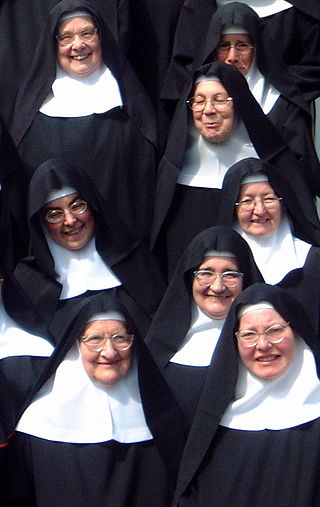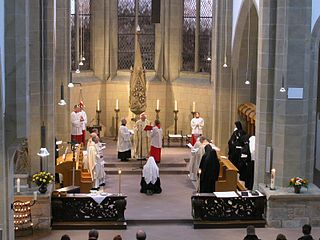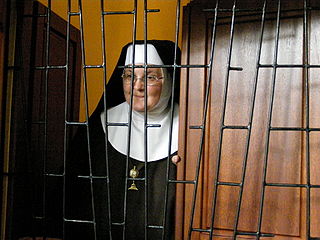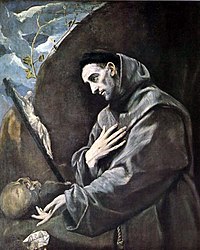
A nun is a woman who vows to dedicate her life to religious service and contemplation, typically living under vows of poverty, chastity, and obedience in the enclosure of a monastery or convent. The term is often used interchangeably with religious sisters who do take simple vows but live an active vocation of prayer and charitable work.
A religious order is a lineage of communities and organizations of people who live in some way set apart from society in accordance with their specific religious devotion, usually characterized by the principles of its founder's religious practice. It is usually composed of laypeople and, in some orders, clergy. Such orders exist in many of the world's religions.
A solemn vow is a certain vow taken by an individual during or after novitiate in a Catholic religious institute. It is solemn insofar as the Church recognizes it as such.
In the Catholic Church, a religious profession is the solemn admission of men or women into consecrated life by means of the pronouncement of religious vows, typically the evangelical counsels.

Religious vows are the public vows made by the members of religious communities pertaining to their conduct, practices, and views.

The Dicastery for Institutes of Consecrated Life and Societies of Apostolic Life, formerly called Congregation for Institutes of Consecrated Life and Societies of Apostolic Life, is the dicastery of the Roman Curia with competency over everything which concerns institutes of consecrated life and societies of apostolic life, regarding their government, discipline, studies, goods, rights, and privileges.
Canons regular are priests who live in community under a rule and are generally organised into religious orders, differing from both secular canons and other forms of religious life, such as clerics regular, designated by a partly similar terminology.

Consecrated life is a state of life in the Catholic Church lived by those faithful who are called to follow Jesus Christ in a more exacting way. It includes those in institutes of consecrated life, societies of apostolic life, as well as those living as hermits or consecrated virgins/widows.
An institute of consecrated life is an association of faithful in the Catholic Church canonically erected by competent church authorities to enable men or women who publicly profess the evangelical counsels by religious vows or other sacred bonds "through the charity to which these counsels lead to be joined to the Church and its mystery in a special way". They are defined in the 1983 Code of Canon Law under canons 573–730. The Congregation for Institutes of Consecrated Life and Societies of Apostolic Life has ecclesial oversight of institutes of consecrated life.
A religious congregation is a type of religious institute in the Catholic Church. They are legally distinguished from religious orders – the other major type of religious institute – in that members take simple vows, whereas members of religious orders take solemn vows.

Enclosed religious orders or cloistered clergy are religious orders whose members strictly separate themselves from the affairs of the external world. In the Catholic Church, enclosure is regulated by the code of canon law, either the Latin code or the Oriental code, and also by the constitutions of the specific order. It is practised with a variety of customs according to the nature and charism of the community in question. This separation may involve physical barriers such as walls and grilles, with entry restricted for other people and certain areas exclusively permitted to the members of the convent. Outsiders may only temporarily enter this area under certain conditions. The intended purpose for such enclosure is to prevent distraction from prayer and the religious life and to keep an atmosphere of silence.
Regular clergy, or just regulars, are clerics in the Catholic Church who follow a rule of life, and are therefore also members of religious institutes. Secular clergy are clerics who are not bound by a rule of life.
Precedence signifies the right to enjoy a prerogative of honor before other persons; for example, to have the most distinguished place in a procession, a ceremony, or an assembly, to have the right to express an opinion, cast a vote, or append a signature before others, to perform the most honorable offices.
A religious brother is a member of a religious institute or religious order who commits himself to following Christ in consecrated life of the Church, usually by the vows of poverty, chastity and obedience. He is usually a layman and usually lives in a religious community and works in a ministry appropriate to his capabilities.
This is a glossary of terms used within the Catholic Church. Some terms used in everyday English have a different meaning in the context of the Catholic faith, including brother, confession, confirmation, exemption, faithful, father, ordinary, religious, sister, venerable, and vow.
"A religious institute is a society in which members, according to proper law, pronounce public vows, either perpetual or temporary which are to be renewed, however, when the period of time has elapsed, and lead a life of brothers or sisters in common."
In Catholicism, "of pontifical right" is the term given to ecclesiastical institutions either created by the Holy See, or approved by it with the formal decree known by the Latin name decretum laudis. The term is included in the names of institutions, often capitalised in English: "Institute of [xxx] of Pontifical Right".
In the canon law of the Catholic Church, a person is a subject of certain legal rights and obligations. Persons may be distinguished between physical and juridic persons. Juridic persons may be distinguished as collegial or non-collegial, and public or private juridical persons. The Holy See and the Catholic Church as such are not juridic persons since juridic persons are created by ecclesiastical law. Rather, they are moral persons by divine law.

A religious sister in the Catholic Church is a woman who has taken public vows in a religious institute dedicated to apostolic works, as distinguished from a nun who lives a cloistered monastic life dedicated to prayer. Both nuns and sisters use the term "sister" as a form of address.
In some religious orders of the Catholic Church, a congregation is a group of religious houses. In monastic orders, this would be monasteries; in orders of canons regular, this would be chapters. Each congregation operates as an autonomous or independent subdivision of the religious order, and is presided over by a superior with a title such as abbot general, arch-abbot, abbot president, president, abbot ordinary, provost general or superior general.















